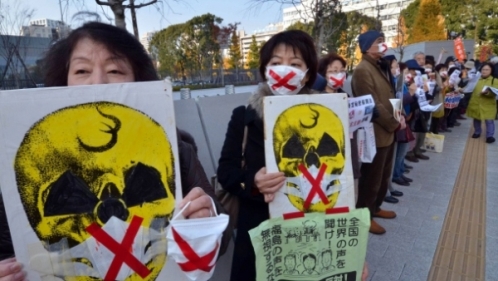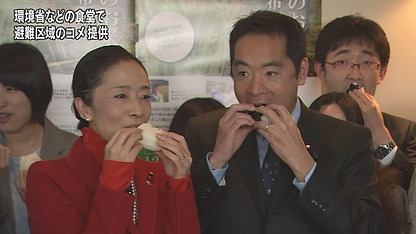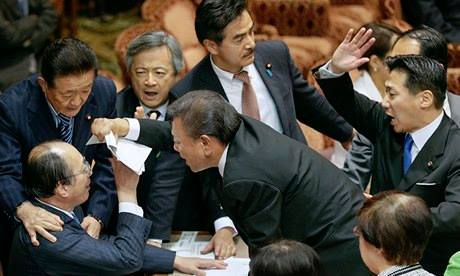Insight - Fukushima water tanks: leaky and built with illegal laborBY ANTONI SLODKOWSKI
NAHA, Japan Thu Dec 5, 2013 4:25pm EST
An aerial view shows the Tokyo Electric Power Co.'s (TEPCO) tsunami-crippled Fukushima Daiichi nuclear power plant and its contaminated water storage tanks (top) in Fukushima, in this photo taken by Kyodo August 31, 2013. REUTERS-Kyodo
1 OF 2. An aerial view shows the Tokyo Electric Power Co.'s (TEPCO) tsunami-crippled Fukushima Daiichi nuclear power plant and its contaminated water storage tanks (top) in Fukushima, in this photo taken by Kyodo August 31, 2013.
CREDIT: REUTERS/KYODO
(Reuters) - Storage tanks at the Fukushima nuclear plant like one that spilled almost 80,000 gallons of radioactive water this year were built in part by workers illegally hired in one of the poorest corners of Japan, say labor regulators and some of those involved in the work.
"Even if we didn't agree with how things were being done, we had to keep quiet and work fast," said Yoshitatsu Uechi, 48, a mechanic and former bus driver, who was one of a crew of 17 workers recruited in Okinawa and sent to Fukushima in June 2012 - among the thousands of workers from across Japan who have put together the emergency water tanks and stabilized the plant after three reactor meltdowns that were triggered by the March 2011 earthquake and tsunami.
The Okinawa crew was recruited by Token Kogyo, an unregistered broker, and passed on to work at the Fukushima plant under the direction of Tec, a larger contractor which reported to construction firm Taisei Corp, records show. That practice of having workers hired by a broker but managed by another contractor is banned under Japanese law to protect workers from having their wages skimmed and to clarify who is responsible for their safety.
In September, Okinawa labor regulators sanctioned Token Kogyo after investigating a complaint by Uechi and concluding the broker improperly sent workers to Fukushima, said an official with knowledge of the order, which was not made public. The official said Token Kogyo did not have the required license to dispatch workers. Japan's labor laws also prohibit third-party brokers from sending workers to construction jobs like the tank assembly where the Okinawa crew was employed. The sanction is a written order to improve business practice.
At Fukushima, the workers from Okinawa were told by a Tec supervisor to lie to the plant's operator, Tokyo Electric Power Co, and say they were employed by Tec, according to Uechi, three other workers, employment documents and a recording of a workplace briefing reviewed by Reuters.
"People didn't have contracts, so when they weren't needed any more, they were cut immediately," said Uechi. Other members of the Okinawa-hired crew confirmed details of his account, but asked not to be named.
Tokyo Electric, or Tepco, declined to comment on the specifics of the Okinawa crew, citing a need to protect the confidentiality of worker complaints brought to its attention and an inability to confirm relevant facts. Taisei declined to comment in detail, saying it "appropriately instructs its sub-contractors and tightly monitors its network of contractors."
Token Kogyo declined to comment on Uechi's case but confirmed it had sent some workers to Fukushima from Okinawa. Tec did not respond to repeated requests for comment.
QUALITY CONCERNS
Uechi complained to Tepco about work conditions at Fukushima in a series of phone calls beginning in August 2012, he said. He described his concerns about the quality of work at the plant in interviews with Japan's Chunichi newspaper and the Associated Press this year. The illegal employment practices and the sanction against Token Kogyo have not been previously reported.
Tepco has promised to improve working conditions in an unprecedented nuclear decommissioning project expected to take more than 30 years. [ID:nL4N0J31FR] The company said last month it would more carefully monitor sub-contractors and double the pay for thousands of workers after a Reuters report found widespread abuses, including falsified employment records, skimmed wages and a lack of worker contracts. [ID:nL4N0HS0UJ]
"Ensuring all workers at Fukushima are being employed appropriately is a very high priority that has a direct relation to our ability to bring a close to the accident," Tokyo Electric said in a statement. "We are working with all our contractors and others to ensure that laws and regulations are observed."
Yosuke Minaguchi, a lawyer who has represented Fukushima workers, said problems in enforcing labor standards in the nuclear clean-up could threaten its completion.
"I have seen many younger workers drop out of the clean-up after they had their wages skimmed or after facing dangers that were not explained to them," he said. "Without stronger labor protection, there's no way the decommissioning project will succeed."
RADIOACTIVE WATER
Since the 2011 disaster, huge volumes of radioactive water have built up at the Fukushima site, with some leaking into the nearby Pacific Ocean. As an interim measure, Tepco rushed an order for steel tanks that could be put together quickly after being shipped in parts and assembled on site.
These bolted-style storage tanks, each as tall as a 3-storey building, were intended to last only until 2016, giving Tepco time to have a purification system in place so contaminated water could be cleansed and safely discharged.
In August, one of the tanks was discovered to have leaked about 300 tons of water, raising global alarm over Japan's handling of the crisis and prompting the government to order that the makeshift, bolted tanks like those assembled by the Okinawa crew be replaced by sturdier, welded tanks.
Weeks later, radiation at the ground near one of the tanks spiked to a level so high that it would have caused radiation sickness within an hour if a worker had been directly exposed. That spike, after an apparent leak of radioactive water, occurred in the same area where Uechi and the Okinawa crew had been working - an open space known as H3 on an elevated plain above Fukushima's four wrecked reactors.
"Yes, we did a shoddy job," said one of Uechi's co-workers, who didn't want to be named as it could jeopardize his job prospects. "The quality of what we did was low, but what else would you expect? We had to race to finish up the tanks." The worker quit after only a month at Fukushima due to the fear of radiation. He now works on a construction site in Okinawa.
Uechi says he spent much of his six months at Fukushima complaining about work standards and working conditions and being ignored. He said workers building the storage tanks last year never felt able to call attention to defects.
In one example, Uechi said workers were rushed to apply caulking to seal the tanks even when it was raining and snowing. "It didn't make any sense, because the caulking wouldn't get to the metal. It would float out," Uechi said. Tepco said it could not confirm details reported by Uechi, but said workers should not have been working on sealing the tanks in the rain because it could have made the sealant in the tanks more prone to fail.
RECRUITMENT
Token Kogyo, the broker that recruited Uechi and other workers, operates in the suburbs of Naha, the largest city on Okinawa island, a 2-1/2 hour flight southwest of Tokyo. The firm is involved in building work on the island and targets seasonal workers willing to travel to construction jobs in Japan's larger cities, job ads issued by the company and posters on the building housing the firm show.
As of September, government data showed there were fewer than six job openings for every 10 seeking work in Okinawa. By contrast, there were as many as 12 openings for every 10 workers in Fukushima prefecture, where mass evacuations have hobbled the reconstruction effort.
Uechi, who has three school-age children, said he was lured by the promise of pay that would be more than twice the minimum wage in Okinawa. He and the other workers were only told they were going to the Fukushima nuclear plant at the job interview.
Workers were housed three or four to a small room, and work conditions were tough. The day would start with breakfast at 5 a.m. at a highway rest-stop now housing workers. Protective suits were hot in summer, and the work was cold in winter. Five of the 17 of the Okinawa hires quit in the first month. Only three, including Uechi, lasted until December, he said.
The Okinawa crew were all paid without any documentation before Uechi complained to Tepco, which ordered Taisei to investigate. As a result, Tec supervisors brought the Okinawa crew into a room in August 2012 and asked them to fill out a confidential survey requested by Tepco on work conditions.
On a recording of that meeting which Uechi said he made, a person he identified as a Tec supervisor is heard telling workers they should report that they were receiving hazard pay and were employed by Tec. That was untrue as they had been hired by Token Kogyo and paid for their early work at Fukushima by the broker, Uechi said and his bank records show.
"When it comes to our sub-contractors, we register them all as Tec," the supervisor is heard to say. "If you want to say that's a forgery, then, yes, it's a forgery."
Uechi declined to fill in the form as instructed, and continued to complain to Tepco. Later that month, Tec gave Uechi a contract until end-December and increased his pay to 16,000 yen ($160) a day from 13,000 yen. It was not clear if other workers were given contracts, though Uechi said others were given a similar pay rise.
Uechi said he was sent home with almost three weeks left on his contract. He was told that was because Taisei had lost a bid for a new job at the plant. Taisei declined to comment on that matter. Tepco said it was "not in a position to know the details of the contract terms."
ONE MILLION YEN
In January of this year, when Uechi pressed his complaints with regulators and began speaking to reporters about his experience, Tec Chairman Yasushi Ogawa visited Okinawa and handed Uechi 1 million yen ($9,800) in cash. Ogawa said this was for "unpaid wages and compensation," Uechi said. He said Ogawa asked him not to complain to Taisei again at that meeting.
Uechi accepted the payment but pressed Tec to provide a breakdown of the money for tax purposes. Reuters reviewed a recording of the meeting Uechi said he had made and a document he said Ogawa asked him to sign when handing over the money.
Tec referred all questions to Ogawa. Reached by phone, Ogawa said he could not comment until mid-December at the earliest, and might not be able to comment at all on the case.
For his part, Uechi is preparing to go back to Fukushima.
He hopes to find a job in the decontamination around the plant that is being undertaken so tens of thousands of evacuees can return home. His unemployment benefits ran out in June and his family needs the money, he said.





